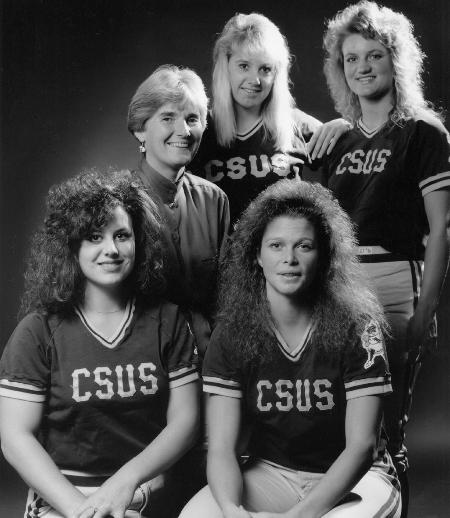‘Shea Stadium of West’

Former Sac State softball coach Irene Shea on the cover of the 1990 media guide with (front row l to r) Karen Andreotti and Toni Heisler, and (back row l to r) Cary Gessell and Terri Eagelston.:Courtesy Hornet Sports
April 10, 2008
A trip to New York can be very inspiring for those who are lucky enough to make it.
For the 1987 Sacramento State softball team a visit to Long Island, N.Y., proved to be all it needed to change the face of where its games were held.
Then-coach Irene Shea took the team east for a tournament in Long Island, and in the team’s free time is when the idea of Shea Stadium was born.
After visiting Shea Stadium, home of the New York Mets, and arriving back at Sac State in the midst of a renovation, the team got to work in giving its facilities a facelift.
“The team wanted to make it the Shea Stadium of the West,” Shea said.
Shea, who had only been the team’s coach for a year, along with the assistance from other coaches and players, sought for the donation of building materials and money.
In the summer of 1987, the team worked together to create a cinder block dugout and a permanent fence around the outfield, along with a batting cage and a pitching mound.
Prior to that renovation, the field used a portable fence that needed to be put up before every home game, and the dugout consisted of a wooden bleacher behind a fence.
“She was out there helping with the labor the whole time, and she wasn’t afraid of the hard work that was needed to change the softball field into Shea Stadium,” said Lois Mattice, associate athletic director of internal affairs.
Shea was not only an influential figure in softball just for the Hornets, but for the entire NCAA.
In 1988 she bid to host the NCAA Division II softball nationals, which were played at the Sacramento Softball Complex.
In both 1988 and 1989 the Hornets were among the elite teams of Division II, with fifth and second place finishes, respectively.
Shea was a member of the NCAA softball committee throughout the 1990s, which helped change the color and overall design of the actual ball.
“She was instrumental in changing the dramatics of the game to make it more fan-friendly,” Mattice said.
Current head coach Kathy Strahan, who took over for Shea on a permanent basis in 1993, has high praises for Shea.
“Irene was a very good coach as her record indicates. She was well-liked and easily approachable,” Strahan said.
When Strahan took over the head coaching position, Sac State softball was only in its fourth year in Division I.
Shea paved the way into Division I in 1990, when the Hornets posted a 31-28 record in its inaugural season and were ranked in the NCAA’s top 20 list for several weeks.
Taking over the coaching position after it had been vacated by a person of Shea’s caliber wasn’t easy – Strahan can vouch for that.
“My first year was difficult – a new coach comes in with a new philosophy and a new way of doing things. But I never viewed it as coaching in Irene’s shadow,” Strahan said.
It helped that Shea stuck around after retiring as coach and took the job as associate athletics director because it provided Strahan with an outlet for advice.
“Irene was helpful then and she was easy to build a strong bond with because we had so much in common with softball,” Strahan said.
The coaching ranks at Sac State weren’t the first time Shea and Strahan had crossed paths.
Both played softball at different times in their careers for Ralph Raymond.
Shea had played professional softball for the same team that had drafted Strahan, but Strahan opted out of professional softball in order to keep her amateur status open for the 1979 Pan American team.
Athletics Director Terry Wanless caught the tail end of Shea’s career at Sac State, but he still was able to befriend her and gain help from her when he needed it.
“She was a great help to me, to understand the internal operations of the department. She helped create a sense of continuity in the program,” Wanless said.
One other thing that has remained a constant in the softball program, besides the name of the stadium, is the academic success it has had.
“It has continued to be a very good, strong program that makes sure student-athletes graduate,” Shea said.
Wanless echoes similar sentiments. “I’m proud of the academic and on-the-field success the softball program has had,” he said.
Retiring from Sac State hasn’t been a negative for Shea.
“It’s wonderful – one of the best jobs I’ve ever had,” Shea said.
Mattice credits Shea and Debby Colberg as being influential figures behind the success of the women’s intercollegiate sports program here at Sac State.
?? ?? ??
Contact Jose Martinez in the
Sports department at
(916) 278-5145




























































































































